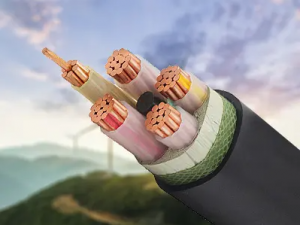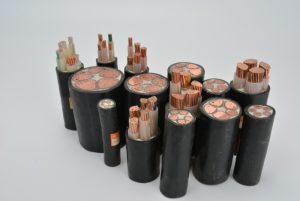随着社会的发展, 电线和电缆的要求也在增加, 电线和电缆的分类越来越详细, 例如防火, 不易燃的, LSZH电缆也出现在我们的日常生活中.
LSZH电缆是什么电缆?
低烟, 顾名思义, 电缆燃烧时减少有害物体的产生.
卤素是人体的有毒气体, 无卤素不是有毒气体释放, 通常对于电缆,如果发生火灾.
低烟的无卤素电缆也可以称为环保电缆, 其中大多数用于对环境健康有严格要求的医院和地方.
含卤素的阻燃电缆绝缘, 鞘, 外护套, 和辅助材料包裹并填充全部或部分含卤素的聚乙烯PVC火焰材料, 因此具有良好的阻燃性能.
但是在电缆中, 燃烧将释放大量烟雾和卤代气体, 周围电气设备上的卤代气具有腐蚀性危险, 救援人员需要戴上防毒面具才能扑灭现场.
因此,对于这些电线和电缆以及如何识别它们. 出色地, 以下ZMS电缆编辑器给大家 低烟的无卤素和电缆 方法!

可以通过以下方面来识别.
产品 氮AME 我牙齿化 中号小说
金属丝 – 低烟雾卤素阻燃的聚乙烯绝缘线和电缆
电缆 – 聚乙烯绝缘LSZH火焰阻滞剂护套电源线
模仿产品通常会有一些不同的名字, 例如聚乙烯绝缘材料低烟雾无卤素的护鞘火焰电源线, 等等.
LSZH电缆皮肤 乙ur 中号小说
1 用焊接铁燃烧隔热层通常不会有明显的凹痕, 如果有较大的凹痕表明使用材料或过程缺陷的绝缘层.
2 或打火机烧烤, 在正常情况下, 不容易点燃.
即使燃烧, 长时间燃烧后 电缆绝缘层 仍然相对完整, 没有烟和刺激性的气味, 虽然直径增加.
3 如果很容易点燃, 可以确定电缆的绝缘层不使用LSZH电缆材料, 最有可能的聚乙烯或交联聚乙烯材料.
4 如果有大烟, 这意味着绝缘层使用含卤素的材料.
如果长时间燃烧后绝缘表面严重剥离,并且直径不会显着增加, 这意味着没有进行任何合适的辐射交联过程.
热的 瓦Ater 我mmersion 中号小说
将核心或电缆浸入热水中 90 ℃. 在正常情况下, 绝缘电阻不会迅速下降,并保持在 0.1 MΩ/km.
如果绝缘电阻急剧下降甚至低于 0.009 MΩ/km, 这意味着尚未通过合适的辐照交联过程处理它.
笔记: 聚乙烯或交联的聚乙烯绝缘材料不适用于这种鉴定方法, 可以通过上述第二篇文章中的方法来识别.
密度 C保单 中号小说
低烟的无卤素材料比水更稠密, 您可以将少量绝缘层剥落到水中, 如果它漂浮在水面, 它不是低烟的无卤素材料.
普通电缆的差异
低烟和无卤素的电缆可能会被燃烧,并且在发生火灾的情况下不运行, 但是它可以阻止火的传播.
通俗地说, 如果发生缆线火, 它可以将燃烧限制在局部区域,而不会产生传播, 保留其他各种设备并避免更大的损坏.
根据电缆的不同阻燃材料, 阻燃电缆分为两类: 含卤素的阻燃电缆和无卤素的低音阻燃电缆.
环保电缆的定义
环保电缆是使用前后使用前后不产生有毒和有害物质的电缆, 例如铅等重金属, 镉, 六价铬, 汞, ETC。, 不包含溴化阻燃剂, 并由SGS认可的测试组织测试环境绩效, 并满足欧盟环境指令,并且高于其指数要求.
没有有害卤素气, 没有腐蚀性气体, 低燃烧热, 没有土壤污染线, 和电缆.

LSZH电缆的应用是什么?
低烟卤素的电缆产品的应用主要集中在大型项目领域, 和高科技领域.
例如, 铁路, 地铁, 汽车, ETC. 中国在铁路网络的建设中, 牵引电缆, 信号电缆, 控制电缆, ETC. 使用低烟雾卤素的产品来保护乘客安全.
在各个地方的新地铁项目也不例外, 所有使用LSZH产品.
汽车场还开始认识到低烟无卤素产品的重要性, 大多数布线都使用LSZH电缆.
在日常生活中, 低烟无卤素的电缆广泛用于核电厂, 地铁站, 电话交换机和计算机控制中心, 高层建筑, 酒店, 广播电台和电视台, 重要军事设施, 和石油平台, 以及更集中的地方和低空密度.
提高家中电路的安全性, 这 ZMS电缆制造商 建议您将低烟和无卤素阻燃电缆作为家庭接线.
ZMS电缆始终使用高纯度 无氧铜 作为消除超负荷发生的核心, 在使用自发展的环保材料作为绝缘材料的同时, 大大降低了泄漏和短路的风险, 为您的家人带来多种保护, 因此,电缆与国家标准一致,以真正保护我们的生活.
不要抱怨, 事故发生后, 为时已晚,不后悔!
